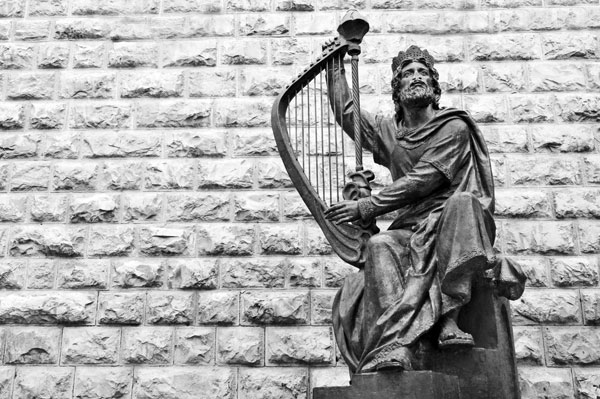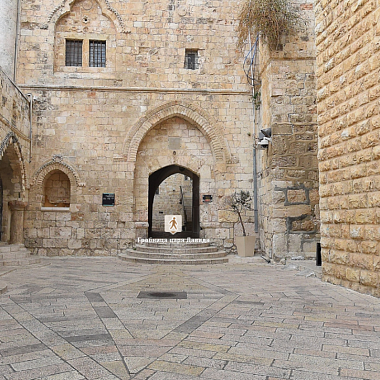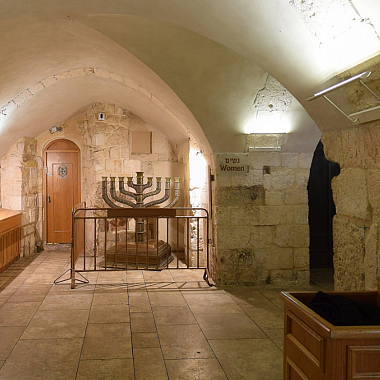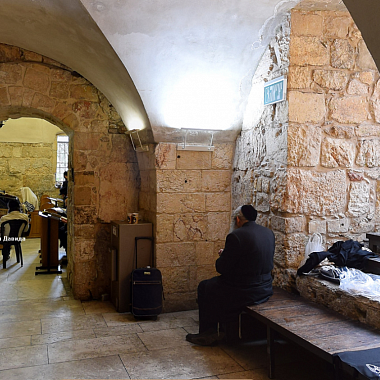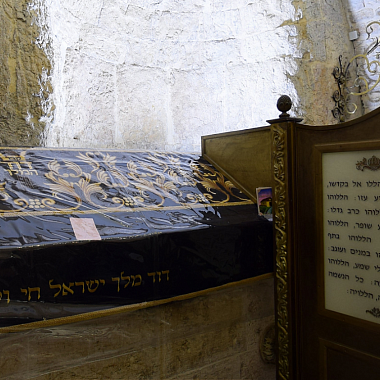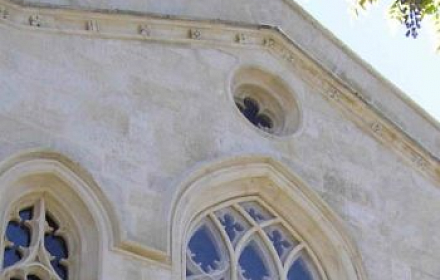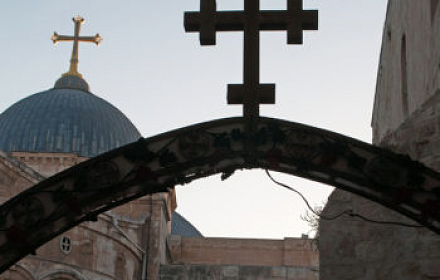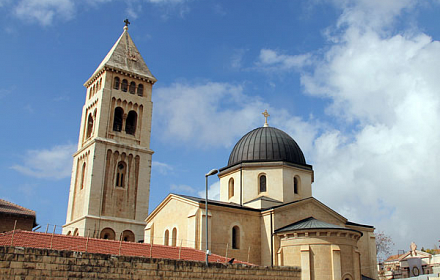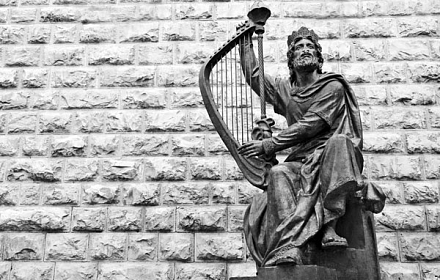About Virtual Tour
Street
Both the Cenacle and the burial place of David, King of Israel, Prophet and author of the Psalms are located on the same site on Mount Zion.Historical records indicate that one of the seven synagogues on mount Zion once stood upon the site of David’s burial. The place is accessible from the Franciscan monastery’s inner courtyard. On its different levels the building contains the Cenacle and David’s tomb – it changed hands a number of times from one religious confession to another, and so on, — that is why now it preserves the traces of various time periods and architectural styles. For instance, there is a mosaic niche in the southern wall called “mihrab” — it dates back to Mamelukes times and indicates the point nearest to Mecca, toward which the congregation faces to pray. You won’t see it today as the niche is hidden behind the bookshelves. Let's go on a virtual pilgrimage
The visitors who go into the next room will see a giant sarcophagus. According to tradition, inside lay the remains of king David. The sarcophagus is covered with a velvet cloth bearing an inscription in Hebrew reading “King David of Israel lives on and exists”. These words refer to a beautiful ancient legend according to which after King David’s death all light disappeared from the earth. King’s son Solomon prayed to God, questioning: “What should we do without light? What should we do without King David?” The answer given from above was the phrase inscribed on the velvet cloth — and there was light again.
The velvet cloth is adorned with Torah scrolls from Jewish synagogues that were destroyed during the Holocaust. The tombstone has ornamentation carved in the style of Jerusalem Kingdom — probably around the beginning of the early 12th century.
Entrance
Today the building that houses King David’s sarcophagus is a part of yeshiva — synagogue and Jewish religious institution.The celebrated Old Testament king’s tomb was discovered in the 12th century at the time the Crusader church “Our Lady” was constructed. Actually, it would be better to call it a reconstruction, rather than construction: earlier, in the 4th century AD it was the site of a church built on the orders of St. Helen, Equal-to-the-Apostles, subsequently destroyed by Muslims. Over the centuries, Persians, Crusaders, Saladin’s warriors, Ottoman Turks and Christian monks succeeded each other — this is why there is a considerable lack of detail in the story of this place. In the 14th century the construction of a church by Franciscans provoked a standoff between the Christians and Jews of the Holy Land, echoed with the surge in Anti-Semitism in Europe.
The Muslims, who at that time reigned over Palestine, found a simple way to resolve this dispute — they seized the building and transformed into a mosque called Nebi Daoud. This is because the biblical prophet and king has been also venerated by the supporters of Islam.
As for the Jews, for them King David’s tomb has been one of the holiest shrines, comparable only to the Wailing Wall. This was most vividly demonstrated in the years of Jordanian occupation, when there was no access to the Wall and thousands of Jews from all over the world came to King David’s tomb for a prayer.
Inside the building
A pleasant coolness and a library-like silence, beautiful vaulted ceilings and many explanatory notes in Hebrew — these are the several rooms of the Jewish seminary, where the biblical king’s sarcophagus now stands.It is hard to overestimate the role of King David for the Holy Land and Christianity. The Savior Jesus Christ descended from David. A simple shepherd armed with a sling that engages into the fight against the giant Goliath and defeats him, a man skillful on the lyre, able to quiet down King Saul’s disordered mind with his music, and finally, a runaway who found shelter among his yesterday’s enemies – Philistines. From his youth on, David had a great love and an absolute trust in God. After two years of civil conflict, the prophet Samuel anointed David to be king of Israel.
David was a great king, who established a huge kingdom that stretched from Sinai to Euphrates. Jerusalem was not only its capital, but also its spiritual center, where the Ark of the Covenant was brought. But the temple to house the Ark was constructed under Solomon – David’s son.
David and poets close to him were the authors of lyrically emotional prayers — psalms, which are daily recited in Christian worship around the world. The King and Psalmist spent seventy years on this earth and was buried in Jerusalem. Although up to now the historians dispute about the exact place of burial of the biblical king, each year his tomb on Mount Zion is visited by many pilgrims and tourists.
KING DAVID’S TOMB
The tomb of King David is located on Mount Zion near the Catholic Abbey of the Dormition, and is easily found by visitors of Jerusalem thanks to a monument that stands outside the entrance. Its authors are Russian sculptors Alexander Dyomin and Alexander Ustenko, who depicted the biblical king sitting with a musical instrument in his hands. The prophet’s head is raised — as if awaiting divine inspiration of the Holy Spirit, which would result in lyrically emotional lines of a new psalm. Perhaps, this is the best way we can visualize the Psalmist.But there is also another David — a dedicated political leader recognized as a king by all Israeli tribes. He moved the capital to Jerusalem — a strong fortress situated on the border between the lands of the tribes of Benjamin and Judas. Thanks to its location, it quickly became a booming city – one of the richest across the Middle East. Since that period began the flourishing of the Jewish Kingdom, the glory of which was further increased by David’s son — The Wise Solomon.
This all will happen much later. First, David had to conquer powerful foes: Philistines, Moab and Edomites — and at the same time to win over the influential ally in the name of Phoenicians. In fact, the Jewish Kingdom soon reigned over the whole of western Asia, and King David himself lived to see an incredible economic boom and thriving arts & culture, especially in the field of religious poetry. He also left his son Solomon the drawings for building the Temple of Jerusalem and sufficient funds to implement its construction.
Not being a sinless man, David was nevertheless designated by God to serve as poet, king and prophet. And, one must admit, he fully realized his mission. For thousands of years throughout the whole world he has remained one of the most brilliant figures in the history of Jewish people. His gift of prophecy is recognized and revered by followers of the three world religions.
Send donation
If you are in a difficult financial situation, we will light the candle for free. For that purpose email us at coordinator@santosepulcro.co.il
Payment Methods
